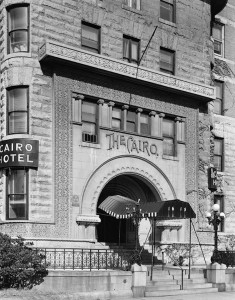Retracing Lili‘u’s Footsteps…
Purely by chance, I found myself in the Washington, D.C. neighborhood where Hawai‘i’s last queen, Lili‘uokalani, had once lived.
I was in Washington, D.C. to deliver a talk to a group of Treasury executives about my new book, Lost Kingdom: Hawaii’s Last Queen, the Sugar Kings, and America’s First Imperial Adventure. I’d booked a hotel near Dupont Circle.
The evening after the Treasury talk, I was on my way to a dinner party thrown by a group of college friends and stopped at Cairo Wine & Liquor, a small shop a few blocks away from my hotel, to pick up a bottle of wine.
The shop’s name caught my eye and I asked the man behind the counter whether the Cairo apartment building was nearby.
“Sure is,” he answered, motioning across 17th Street, to 1615 Q Street, N.W. “It’s right around the corner.”
“That’s where Hawai‘i’s last queen once lived… “ I said, as I handed him my credit card.
I’d visited the building four years ago, early on in my effort to retrace Lili‘u’s steps. I hadn’t remembered where it was, but distinctly remembered the gargoyles on the outside and dramatic Romanesque entry arch.
“Before or after she was kicked off the throne?” he asked, shaking his head.
“Afterwards,” I said, a bit surprised that the man at the register, who was perhaps in his late forties, knew the history that had led to the end of the independent Kingdom of Hawaii. I am about his age and this episode of American history was never taught in any of my classes growing up.
I walked out of the shop, having found a connection between a U.S. Marine-backed coup that had taken place 119 years earlier in a remote island kingdom and a Washington, D.C. liquor store.
Lili‘u had arrived in the nation’s capitol in January of 1897, where she moved into what was then a chic luxury hotel. In her suite of rooms, she penned her autobiography, Hawaii’s Story, working closely with the American journalist Julius Palmer in an ultimately unsuccessful effort to regain her throne by swaying public opinion and privately petitioning President Grover Cleveland.
The next morning, I decided to revisit the Cairo – the building, not the liquor store. When it was constructed in 1894, it was the tallest building in Washington, at a soaring 156-feet. Concerns over its safety led the city to pass local height restriction legislation and for many years, it remained the capital’s tallest residential building.
When Lili‘u moved there in 1897, it had 350 rooms, suites on every floor, a dining room, a grand ballroom, a nightclub, a billiard room, a barbershop, a bowling alley, and (best of all) a tropical garden on its rooftop terrace. In her suite of rooms, Lili‘u would work most mornings in front of an open fireplace with a gas log, translating the lyrics of the hundred of so songs she had composed into English, as well as completing her autobiography.
The Cairo went downhill in the decades after Lili‘u lived there. As the neighborhood around it decayed in the 1950s, 1960s, and 1970s, it served as a student hostel, a temporary shelter for the needy, and finally, a flophouse. It closed in 1972, was sold and renovated into larger apartments over three years.
In 1993 – the centennial of the overthrow and the same year that President Clinton issued a formal apology to the people of Hawai‘i – the Washington Post described the Cairo as sitting like “some massive Byzantine dream” in the midst of a bustling urban neighborhood.
My quick trip to Washington was so much richer for having rediscovered the Cairo. A heartfelt thanks (or mahalo in Hawaiian) to my new friend at the other Cairo (where I bought the bottle of Sonoma-Cutrer) for pointing out this wonderful building.

I really enjoyed your book I received it from goodreads first reads program.When I saw this post my face lit up because I have had Hawaii’s lost kingdom on my brain since reading your book weeks ago.You have made me crave more about the women and men you wrote about.In fact I was just getting ready to watch the movie titled Princess Ka’iulani at 3am lol.So this post was perfect timing for a new fan of yours.Thank you for the wonderful side story.
Dear Amy,
Thank you for your nice note.. i truly appreciate it! I’m hoping to write a blog item about movies that involve Hawaiian history — what did you think of the Ka’iulani film? There’s also a very good PBS American Experience documentary on the queen that you might want to watch next. By the way, I like your motto of “Stay Calm and Read Books.” Good advice for all of us!
Warmly,
Julie